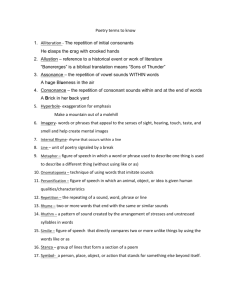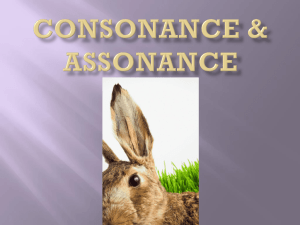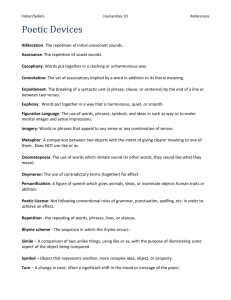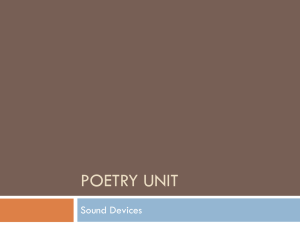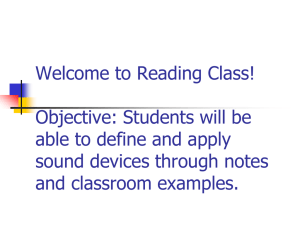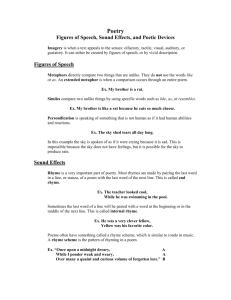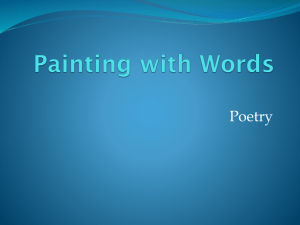Figurative Language
advertisement
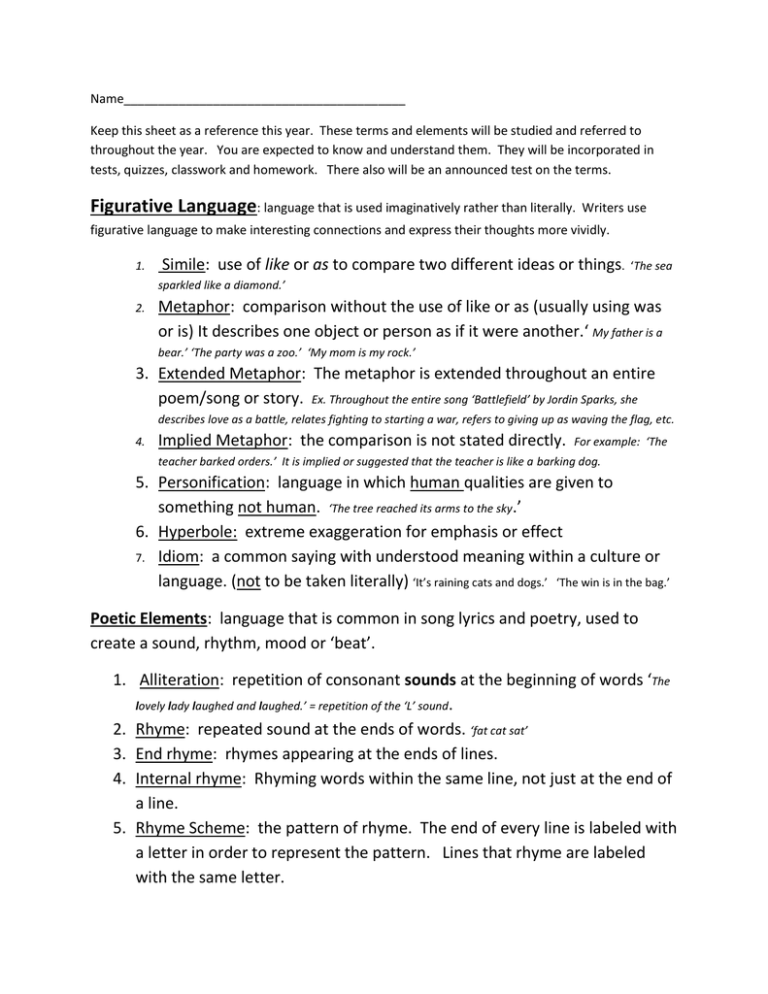
Name_________________________________________ Keep this sheet as a reference this year. These terms and elements will be studied and referred to throughout the year. You are expected to know and understand them. They will be incorporated in tests, quizzes, classwork and homework. There also will be an announced test on the terms. Figurative Language: language that is used imaginatively rather than literally. Writers use figurative language to make interesting connections and express their thoughts more vividly. 1. Simile: use of like or as to compare two different ideas or things. ‘The sea sparkled like a diamond.’ 2. Metaphor: comparison without the use of like or as (usually using was or is) It describes one object or person as if it were another.‘ My father is a bear.’ ‘The party was a zoo.’ ‘My mom is my rock.’ 3. Extended Metaphor: The metaphor is extended throughout an entire poem/song or story. Ex. Throughout the entire song ‘Battlefield’ by Jordin Sparks, she describes love as a battle, relates fighting to starting a war, refers to giving up as waving the flag, etc. 4. Implied Metaphor: the comparison is not stated directly. For example: ‘The teacher barked orders.’ It is implied or suggested that the teacher is like a barking dog. 5. Personification: language in which human qualities are given to something not human. ‘The tree reached its arms to the sky.’ 6. Hyperbole: extreme exaggeration for emphasis or effect 7. Idiom: a common saying with understood meaning within a culture or language. (not to be taken literally) ‘It’s raining cats and dogs.’ ‘The win is in the bag.’ Poetic Elements: language that is common in song lyrics and poetry, used to create a sound, rhythm, mood or ‘beat’. 1. Alliteration: repetition of consonant sounds at the beginning of words ‘The lovely lady laughed and laughed.’ = repetition of the ‘L’ sound. 2. Rhyme: repeated sound at the ends of words. ‘fat cat sat’ 3. End rhyme: rhymes appearing at the ends of lines. 4. Internal rhyme: Rhyming words within the same line, not just at the end of a line. 5. Rhyme Scheme: the pattern of rhyme. The end of every line is labeled with a letter in order to represent the pattern. Lines that rhyme are labeled with the same letter. 6. Consonance: repetition of consonant sounds at the end or middle of words. ‘The brush swished as we pushed past.’ = consonance of ‘sh’ sound. 7. Assonance: the repetition of vowel sounds ‘While at the beach, I can see the sheen of the deep green sea.’ = assonance of the long e sound. (this is not the same as rhyme) 8. Onomatopoeia: words that imitate sounds, ex. ‘hiss’ ‘crash’ ‘boom’ ‘swish’ 9. Repetition: words or lines repeated for emphasis or effect. Literary Terms: These words are used when referring to various aspects of literature. 1. Setting: the time and place of the story 2. Point of View: the perspective from which the story is told. (who is telling the story) First Person: The narrator is part of the action, speaking directly to you, using ‘I’ and ‘me’ to refer to him or herself, speaking only from his or her point of view. Second Person: (not common)The narrator tells the story using the word you. Ex. ‘You walk in the party and realize that you are at the wrong house. You act casual and slip out the back door. You double check the address and go to the party you meant to attend.”This instructions. point of view is used primarily to give Ex. “First you preheat the oven to 350 degrees, then you mix the dry ingredients together ….” Third Person: The narrator is an observer outside the story. Pronouns like ‘he’ and ‘she’ are used to refer to characters. This point of view can be Omniscient (all knowing, meaning the narrator can reveal what all characters are thinking) or Limited Omniscient (the narrator knows the thoughts of one character or a limited number of characters) 3. Rising Action: Events leading to the climax. 4. Falling Action: everything that happens after the climax, as the conflict starts to wind down and move toward a resolution. 5. Climax: the turning point of the story, brings about the resolution. 6. Conflict: the problem that drives the story -Major Conflict: the main problem -Minor Conflict(s): smaller problems within the story -Internal Conflict: occurs within the mind of the character. (person vs. himself) -External Conflict:the character struggles against an outside force. ( person vs. person, person vs. society, person vs. nature) 7. Plot: the sequence of events, what the story is about and how it progresses. 8. Subplot: smaller stories going on within the larger story or plot. 9. Resolution: the way the conflict of the story is resolved. (generally the end of the story) 10.Theme: The lesson to be learned or prevailing message 11.Circular Story: a story that ends the same way it begins 12.Internal Dialogue: dialogue when a character is talking to him or herself (in their head) 13. Stream of Consciousness: a characters unrelated random thoughts 14. Coming of Age Novel: A story in which the main character grows up/learns/loses their innocence. 15. Protagonist: The main character in a story that the reader cares most about, this character’s conflict is central to the plot. 16. Antagonist: the character or force that challenges the protagonist (the villain) 17. Foreshadowing: indication or clues of future events 18. Flashback: a recollection or return to past events in order to give information. 19. Flash forward: a jump forward to actual future events in order to relieve tension in a story or give information. (the story must be a flashback in order to include a flash forward) 20. Allusion: a reference to something well known outside the story or poem to give to give the reader a clearer understanding. Familiarity with the reference is assumed. “ He looked like Edward in Twilight” “He was as important to soccer as Tony Hawk was to skateboarding.” 21. Irony: a contrast between what would be expected and the outcome or reality. (The fire station burned down, the police station was robbed, the health teacher is overweight and smokes..) 22. Symbolism: something represents or stands for something else. (example a peace sign for peace, a heart for love) 23. Tone: the attitude toward the subject matter projected by the author. 24. Mood: Overall feeling a literary work conveys to the reader. 25. Imagery: Vivid descriptions appealing to the senses, also called Sensory Language. 26. Author’s Purpose: the author’s reason for writing (to inform, persuade, entertain, reflect) 27. Author’s Craft or Style: the writer’s distinctive way of ‘speaking’ based on word choice, sentence structure, etc.
